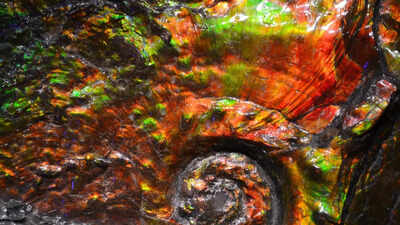Beneath the shale beds of southern Alberta lies one of Earth’s most extraordinary natural treasures, a gemstone that captures light as vividly today as it did when dinosaurs roamed. Known as Ammolite, this fossilised shell gleams with shifting hues of green, crimson, gold, and sapphire, preserved for over 70 million years. Long admired by jewellers and Indigenous communities alike, Ammolite is now drawing the attention of scientists who want to know how its colours have survived the test of time. Research from the University of Alberta, published in Scientific Reports, reveals that its brilliance is no accident but the result of precise nanostructures that manipulate light in ways nature perfected millions of years ago.
How does Ammolite get formed
Ammolite originates from ammonites, spiral-shelled marine animals that thrived in the warm, shallow seas of the Late Cretaceous period. When these creatures died, their shells settled into seabeds that later became part of the Bearpaw Formation, a geological layer stretching across parts of Canada and the United States. Over millions of years, sediment, pressure, and mineralisation transformed these shells into iridescent fossils. While most fossils fade to dull greys or browns, ammonite shells preserved in Alberta’s shale evolved differently. Specific combinations of minerals, mainly aragonite, an unstable form of calcium carbonate, and organic compounds helped lock in their colour. Indigenous Blackfoot communities, who discovered these stones centuries ago, named them Iniskim, meaning “buffalo stone,” and regarded them as symbols of good fortune.In the 1980s, Ammolite was officially recognised as a gemstone, placing Canada alongside countries known for opal, ruby, and jade. Yet, for scientists, its value goes far beyond ornamentation; it is a geological archive of both ancient life and the physics of light.
How Ammolite creates colour
To uncover the origins of its enduring brilliance, researchers from the University of Alberta examined thin sections of Ammolite under electron microscopes. What they found were thousands of stacked layers of aragonite crystals, each only a few hundred nanometres thick. These microscopic sheets act like mirrors that interfere with incoming light, reflecting different wavelengths to produce vivid structural colours, similar to the iridescence seen in peacock feathers, beetle shells, and mother-of-pearl.The colour of each stone depends on the thickness of its layers. Thinner layers reflect blue and green hues, while thicker ones generate reds and oranges. Because natural processes during fossilisation alter these layers unevenly, every Ammolite specimen forms its own distinct pattern and palette.What makes this discovery remarkable is the preservation itself. Normally, aragonite breaks down over geological time, losing its optical properties. In Ammolite, however, trace minerals and bituminous compounds from the surrounding shale stabilised the structure, protecting it from chemical decay. The result is a fossil that still refracts light with near-perfect efficiency, a natural photonic crystal formed before humans even existed.
Where is Ammolite found
Commercial Ammolite mining occurs almost entirely in a narrow stretch of southern Alberta, near the towns of Lethbridge and Magrath. The deposits lie within only a few metres of the Bearpaw Formation, making it one of the most geographically limited gemstones on the planet. Extraction requires patience and precision: the fossil layers are fragile, and even small vibrations can destroy the gem’s surface.Out of hundreds of ammonite fossils uncovered, only a small fraction yield gemstone-quality Ammolite. This rarity, combined with its fiery colour play, makes it one of the most valuable organic gemstones on the market. Yet for local communities, its worth extends beyond commerce. Many still view it as a spiritual object representing renewal and balance, a reminder that beauty can survive through deep time.
The science shaping new materials
Beyond its geological and cultural story, Ammolite offers lessons for modern science. The Scientific Reports study highlights how nature’s microengineering can inspire synthetic materials. The way Ammolite’s nanolayers control and preserve colour could inform the design of photonic coatings, colour-changing films, and optical sensors that mimic its efficiency.By comparing fossilised Ammolite to modern nacre (the material that lines the inside of seashells), researchers found that their optical behaviour remains strikingly similar, despite the vast time gap. This suggests that fossilisation, under the right chemical conditions, can preserve nanoscale order with surprising precision. Such insights could help scientists stabilise modern biomaterials or develop new pigments that retain brilliance without artificial dyes.Ammolite, then, is not just a relic but a natural experiment frozen in stone existing as evidence that biology and physics can converge to create lasting light.
Preserving Ammolite, a finite natural wonder
Because Ammolite exists only in one region, sustainability is central to its future. Mining operations in Alberta are regulated to limit environmental disturbance and require restoration of excavated sites. Scientists and geologists are also collaborating to map potential deposits more accurately, aiming to reduce unnecessary digging.Yet, Ammolite remains finite. Once the Bearpaw Formation’s deposits are depleted, no new sources are expected to emerge. That reality adds urgency to both its conservation and study. Every fragment holds a story that blends geology, evolution, and optical physics, a fusion rarely seen in nature.The gem’s iridescent surfaces, once part of a living marine creature, now offer clues about light’s behaviour and matter’s endurance. To hold a piece of Ammolite is to hold a trace of ancient oceans and a mirror to the planet’s creative power, a reminder that even in deep time, colour can survive.Also Read | Why we see things in the dark: How our brains work in absence of light Go to Source



